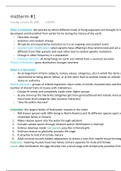Class notes
BIOL1070 in-depth notes and examples from lectures 1-5
- Institution
- University Of Guelph (U Of G )
- Book
- Woodlot Biodiversity
This document is smaller than the other review in this bundle but goes into more depth about the basics of biodiversity, great for a refresh before a midterm or exam. It will help any beginning topics your still confused about to give you a good base to move onto the other document in the bundle
[Show more]




